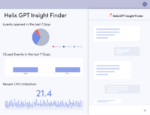
We are at an inflection point in the rise of big data. Enterprise IT infrastructure is producing data at a scale like the world has never seen before. IT operations (ITOps) management has accelerated past the notion of data storage and processing (vis a vis the Hadoop model) and into the world of analytics-as-a-service. We now need systems to drive insights and manage change on-demand. In fact, we need a new operating model for IT in the face of these new effects.
Can a new system save us?
The key to transforming into a responsive, data-driven enterprise—while avoiding a flood of unnecessary processes and over-staffing—is to adapt automation to intelligently consolidate information flows. At the same time, the dynamic nature of today’s IT environment requires IT teams to become literate in a completely new approach to technology, one that spans all functions of the business. Consequently, risks that previously stayed inside organizational units now leak across domains, influencing decision-making for the entire company. These factors will try to pull the organization in multiple directions at once; only a unified data management system with the intelligence to extract operational insights can drive positive business change.
Culture has got to change, too.
Agile processes such as DevOps and AIOps offer mechanisms to control the flow of data and turn it into actionable results. For example, continuous application development and deployment gathers data about functional use, user sentiment, efficiency, and various other metrics to inform the overall process and improve the product. Such rapid dev cycles let organizations identify and fix issues more quickly and with fewer resources, ultimately delivering greater business value.
The resulting streamlined collaboration amongst IT, development, and customer teams improves capabilities, but also introduces dependencies that must be effectively managed. It changes the culture to adapt to the system, and thereby, the system of service delivery will fundamentally affect how organizations are structured, built, and run. Eventually, there will be increased digitization of every human process, and that means human impact will slowly be replaced by AI impact. This doesn’t mean that machines are coming to take our jobs. Instead, it means the modern enterprise IT organization must address a new future. How will it look?
Retraining and Reskilling is a Fact of Life: In a world of dynamic IT, requirements are no longer static, and teams need to be prepared. Organizational units must be able to work in different ways with new technology, with new skills that include robotic emotional intelligence, cloud-native literacy, and infinite adaptability.
System operators become stewards of the business because system operations directly impact business outcomes. It won’t be enough for workers to merely deploy, configure, and manage IT while isolated from the goals of the company, because those goals are inextricably linked to how objectives are achieved through innovation. Employees will need to develop new skills for functioning in a dynamic system. Training staff in agile methodologies, service-oriented software design, and six sigma-style approaches for process improvement will become critical for success.
Automation Is Everything: Automation by policy won’t be enough; even runbooks will become obsolete. Data and results are always changing, so simple automation will not drive meaningful change. Artificial intelligence can be used to drive automation policies and frameworks, with the potential to reduce errors and integrate disparate systems which previously required multiple points of oversight.
The trend towards using AI for data understanding is driving intelligent services into other parts of the business, as well. Rather than just for correlating system and operational data, AI is being adapted to business process optimization. Moving forward, IT operations can begin to run themselves, led by deep data analytics. Alerting and response processes will automatically use their own feedback to update the system’s intelligence, identify emergent trends, and take actions to deliver improved operational results.
Risk Becomes Universal: Increasing connectivity and generalized frameworks (like DevOps and site reliability engineering) mean that risk is no longer siloed to one department or function. It’s spread everywhere, and cascading effects become commonplace.
In general, successful engineering outcomes rely on coordinated processes and policies that dictate operational needs, even after deployment. Introducing connectivity between formerly disparate systems can create instability that potentially affects operations in other, unintended areas. Thus, broad risks arise if different systems can’t interoperate once unified into a single IT ecosystem. Addressing requirements under a generalized framework helps prevent gaps between application implementations.
The System Drags the Company Forward: Insights-driven action will transform digital business well in advance of executive priorities. Change will happen before anyone is ready. Indeed, with so much complexity, so many tools and processes, and so many competing business demands, IT changes now impact culture in entirely new ways.
Business impacts will come from system “intelligence” rather than manual processes. Efficiency in operations management is thus derived from the entire system, including the people themselves. What was previously the IT culture is rapidly replaced with a combination of self-adapting processes and workers who focus more on value than on plumbing.
Transforming the enterprise from silos into integrated platforms will propel the business forward. The resulting system will also drive cultural change at an accelerated rate, perhaps faster than the worker community is prepared to accept, but informed by real data instead of executive intuition.








